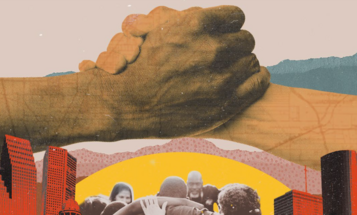
Earth Day Action Shows Fighting Climate Change Means Fighting for Justice
The causes and effects of climate change are interwoven with racial, economic, and political inequity. Groups are building bridges across movements to address these intertwined, wicked problems.
The first Earth Day celebration was an action.
In the late 1960s, communities were feeling the full effects of unregulated industry dumping toxins in their neighborhoods and waterways. Rivers across the country, like the Cuyahoga River in Cleveland, Ohio, were saturated with so much toxic waste they literally caught on fire. In January 1969, an oil spill off the coast of Santa Barbara released over 3 million gallons of oil across 35 miles of Southern California coast. Communities saw the drastic effects of pollution, pesticides, and toxic waste destroying natural life and causing negative health impacts in their neighborhoods. So on April 22, 1970, the first Earth Day, 20 million Americans took to their streets and parks to express their shared frustration at the seemingly endless damage industry was wreaking upon life.
Nearly 50 years later we are witnessing ongoing mobilizations in response to a global climate change crisis. On Monday, April 23, an estimated 1500 people from across the state coalesced at the capitol building in Albany, New York and marched together, calling for Governor Cuomo to end all fossil fuel infrastructure development, put the state on a path to 100 percent renewable energy, and make corporate polluters pay for their climate change-causing emissions.
This rally follows waves of mobilizations across the country. In 2014, over 300,000 people came together in the People’s Climate March in New York City, with parallel marches occurring all over the world. A repeat march took place in 2017 in Washington D.C., with tens of thousands marching to the White House. Today these mobilizations are bringing together vast swaths of the American public, from environmental groups, to racial and economic justice groups, to labor organizations, all of whom recognize that the fight for a livable planet is a fight for justice.
Our democracy and economy are under threat by climate change, which is disproportionately hurting communities of color, low-income families, and young people. The causes and effects of climate change are interwoven with racial, economic, and political inequity. We need bold political action to address the scale of environmental, social, and political crises we face today, and groups are building bridges across movements to address these intertwined, wicked problems.
The first Earth Day was a result of cross-movement solidarity. Labor groups were, some argue, the biggest supporters of Earth Day. The United Auto Workers produced materials and got workers across the country to participate in the nationwide action.
Groups today are building alliances to call on leaders to end the vicious cycles of disenfranchisement of large portions of society. New York Renews,* for example, one of the groups that helped organize the Earth Day action in Albany, brings together over 140 labor, environmental justice, racial and economic justice groups, and others. The coalition is advocating for climate change solutions that invest in and uplift communities of color and low-income, climate-impacted communities in New York State.
In this political moment when the federal government is empowering climate-deniers in its administration, local- and state-level solutions are carrying the momentum forward for climate action. In coalitions like New York Renews, the Alliance for Jobs and Clean Energy in Washington State, and others around the country, environmental justice groups are working with labor and economic justice advocates to advance climate policy that invests in communities.
The first Earth Day action in 1970 helped successfully pressure the federal government to create the U.S. Environmental Protection Agency and pass the Clean Air, Clean Water, and Endangered Species Acts in that year. There is an opportunity in this moment of climate crisis to enact solutions and build a society in which all communities can thrive.
The Climate and Community Protection Act, a piece of legislation New York Renews has been advancing, for example, not only sets a standard for 100 percent renewable energy in the state by 2050, but also requires 40 percent of all state energy funding to go to climate-vulnerable low-income communities and communities of color.
Addressing climate crisis will require rapid economic transformation. This transformation can invest wealth and power in communities. In states across the country, groups are innovating and advancing climate policy that invests climate solutions, good jobs, and needed infrastructure directly in impacted communities and workers.
Monday’s action in Albany saw dozens of such groups from across New York State coming together behind a shared vision for a just and equitable 100 percent renewable energy economy for New York, where corporate polluters pay for their climate pollution.
We need “all hands on deck” to ensure justice in the fight against climate change, and to ensure the needs of the most vulnerable are met in the face of climate catastrophe. By building coalitions and bridging movements, we can win solutions that address environmental crisis, reinvest in our communities, and create a healthy, thriving future for all.
---
*Demos is an active member and supporter of the New York Renews coalition.


